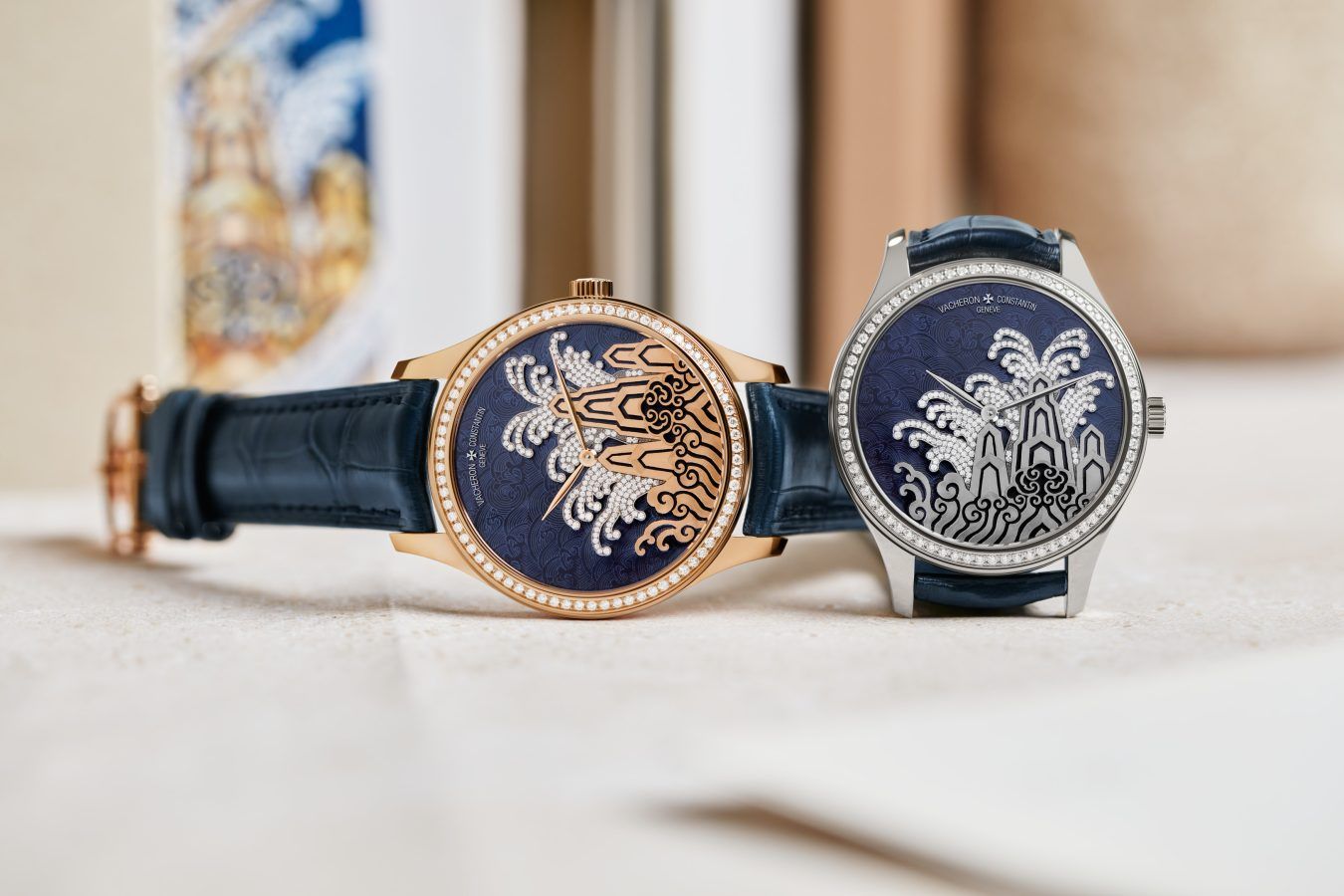A Cultural Collaboration between Vacheron Constantin and Ancient China


Vacheron Constantin pays tribute to ancient Chinese culture with its new Métiers d’Art – ‘Tribute to Traditional Symbols’ series, including two interpretations of the ‘Seawater Cliff ’, a legendary Chinese motif that first appeared in the 14th century.
(Hero image: Tribute to Traditional Symbols – Moonlight Silvers)
The Métiers d’Art – ‘Tribute to Traditional Symbols’ series by Vacheron Constantin offers a journey into the history and culture of China’s last two Imperial dynasties, from the 14th to the early 20th centuries. To immerse itself in the distinctive décor of this period, the watch company took a particular interest in the decorative arts and notably in the ‘Seawater Cliff’ motif omnipresent on courtly architectural elements, but also on furniture and porcelain, as well as on imperial clothing and particularly the so-called ‘dragon’ robes. These richly embroidered silk ceremonial garments conveyed distinctive symbolism according to their motifs.
For this research work, the Swiss watchmaker benefited from the advice of a highly respected former Associate Research Librarian of Palace Museum housed in Beijing’s Forbidden City, known as Mr. Song. In agreement with this expert in Chinese history and symbolism, studies on the dials of the four Métiers d’Art limited editions focused on the ‘Seawater Cliff’ motif. Extensively documented by Mr. Song, this depiction features a mountain towering above the tides with their ebb and flow lashing its cliffs. Embroidered on the lower hem and cuffs of the robe, this ornamentation was regarded as auspicious for those who wore it.

Although water and mountains inspired the decoration of various artefacts in China as early as the Neolithic period – and were represented in an increasingly figurative way throughout the first millennium AD – the combination of the two came later. It was with the Ming (1368-1644) and Qing (1644-1911) dynasties that the motif really took shape. Officially named ‘Seawater Cliff’ under Emperor Wanli (1573-1620), it was reserved for the Imperial family. As its name suggests, this motif refers to the sea, its tides represented by long undulating lines that come crashing down in powerful surges against the cliff. Symbolising the emperor’s immutability faced with the vagaries of life, these overhanging mountain cliffs are unaffected by the waves.
Beating at the heart of the 38mm-diameter case in 18K pink and white gold is in-house Calibre 2460, chosen for its aesthetic appeal and compact dimensions (26.2mm in diameter and 3.60mm thick). The movement’s configuration driving central hands ensures seamless integration with the dial to give scope and depth to the passing hours and minutes. Endowed with a 40-hour power reserve, it meets all the criteria of the Hallmark of Geneva certifying both origin and horological expertise. The 22K gold rotor echoes the symbolism of the dial, since the oscillating weight is delicately engraved with a motif recalling the movement of waves and tides.
Against a star-studded night sky, the mountain peaks, bordered by vegetation in the shape of ginger buds, are caressed by tidal waves. With its colourful aesthetic and respect for traditional Chinese ornamentation, this depiction is a masterpiece of cloisonné enamelling, which originated in China. The technique is also named ‘Jingtai Blue’, which pays tribute to its heyday – the era of Emperor Jingtai in the Ming Dynasty. The latter technique was a natural choice because of the flexibility it offers in terms of both the choice of colours and the graphic design of the intricate shapes.
Laying the 220 gold wires used to delineate the enamelling fields forming the ‘Seawater Cliff’ motif alone requires more than 50 hours of work to shape. This is followed by the enamelling itself in successive layers according to colour and intensity, with a kiln firing between each operation. It takes no less than 70 hours to achieve the rich tones that are so characteristic of this piece. A final polish then completes the work to highlight the gold cloisonné that gives substance to the motif. Finally, a translucent enamel coating instils a unique glow into this highly architectural composition, enhanced by the finesse of the lines and ancestral expertise.

To highlight this enamelling work, the bezel of the model is entirely hand-engraved with a bat motif. In Chinese, “bat” and “happiness” have similar pronunciations – which goes some way to explaining the status of this animal as a harbinger of good fortune. In Chinese decoration, five bats are often seen together, traditionally expressing the ‘Five Good Fortunes’: longevity, wealth, stability, virtue and happiness. On this watch, the engraver has depicted the bat in the form of a frieze – composed of successive volutes representing the animal’s characteristic silhouette.
For this second ‘Seawater Cliff’ motif, the aim was to achieve a depth effect on a monochrome base. Crafted in 18K white or pink gold depending on the model, the all-in-one-piece dial features hollowed waves, blue enamelled parts and raised diamond-set sections for the mountain area. The master artisan uses a blend of techniques to create this composition, endowing the motif with a subtle yet distinctive aesthetic.
According to Christian Selmoni, Style & Heritage Director at Vacheron Constantin, the design department specifically wanted to explore traditional Chinese symbolism for this new Métiers d’Art series. “The aim was to complement the existing offer often found on watch dials celebrating Chinese New Year. In the course of this research, it became clear that the decoration of ancient imperial palaces and the court’s ceremonial robes offered some interesting avenues to explore,” he shares.
For more information, visit vacheron-constantin.com.
Subscribe to our newsletter to get the latest updates.
Thank you for your subscription.